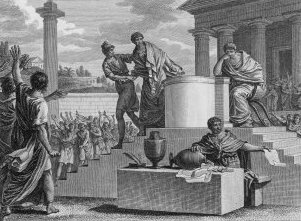 |
| Gladiador Frigio - Jose Maria Labastida - 1824 |
While visiting the National Museum of Art (Museo Nacional de Arte) in Mexico City, I saw Jose Maria Labastida’s Gladiador Frigio Statue today. That is the statue of a naked male warrior holding a sword (unfortunately, the sword doesn’t exist now, it is broken). The thing that motivated me to write this article was the Phrygian Cap on the warrior’s head. Down here in Mexico City, thousands of kilometers away from Anatolia, in the statue of a Mexican sculptor, when I saw the cap with the top pulled forward, symbolizing “freedom” and that belonged to the Phrygians who had lived around Ankara, Eskişehir and Afyon; I thought how small the world is , and how strong the interactions among cultures are.
The Phrygian Cap
The Phrygians lived in 1200 – 700 B.C. in the Mid-West Anatolia based around Sakarya River . The famous “Gordian Knot” story ofthe Phrygians in which Alexander the Great cut the knot with his sword instead of untying it when he came to the capital city of Gordian near Ankara. Though the history of the Phrygian Cap is not exactly known, there might be an epic interpretation on how it came up; as the story of our childhood goes: King Midas wore this cap for the first time to hide his famous donkey ears, then his folk began to wear it to follow after the king, so there came out the conic-shaped, pulled forward, red hat which we call as the Phrygian Cap today.
The Phrygian Cap as a Symbol of "Easterner"
 |
| Paris of Troy - Antonio Canova - 1819 |
We see the Phrygian cap in Anatolian God Attis and the Persian originated Roman God Mithra. When Hellenes came to Anatolia, they used the cap to describe the non-Greek Anatolian folk. For instance; Anatolian, Eastern, Trojan Paris was depicted with the Phrygian cap. The cap was also used to represent The Easterner. In the Basilica of St. Apollinare located in Ravenna, Italy, on the mosaic themed “the three easterner magi announcing King Herod the prophecy of the birth of Jesus Christ”, which is a popular theme in various Orthodox churches, we see “the three easterner magi” with the Phrygian cap symbolizing their being easterners. The interesting thing here is that; the same theme was depicted without the Phrygian cap on the mosaic in Chora Church in Istanbul. It seems “the Easterners” who were portrayed with the Phrygian cap in Italy, didn’t need to wear it any more in Istanbul, i.e. in the East.
 |
| Italy, Ravenna, St. Apollinare Church, "The three easterner magi" |
 |
| Turkey, Istanbul, Chora Church, "The three easterner magi" |
The Phrygian Cap as a Symbol of "Freedom"
In Roman Republic, the Phrygian caps were worn by slaves who had won their freedom. This made the cap turn into a symbol of “freedom” in time. The Phrygian cap was worn by the folk during the French Revolution as a symbol of “rebellion and freedom” and even the national symbol of France, Marianne was depicted with the Phrygian Cap on her head. In 1850, it was abolished to sing the anthem of Marseille and wear the Phrygian Cap in France for about ten years as it implied revolution; then it took its place in French history as a symbol of the revolution.
 |
| The symbol of French Revolution "Marianne" |
In late eighteenth century, just as the French Revolution, it became a symbol of the liberation movements of the Unites States of America against Great Britain. Today we see the Phrygian Cap in the seal of the USA Senate and the flags of New York and New Jersey states.
 |
| The Seal of The USA Senate |
 |
| The coat of arms of Cuba |
Do the people of Afyon, Eskişehir and Ankara know that the cap of their ancestors, who had lived on the same lands before them, is now a symbol of freedom gained through struggle on a great land extending from the South and North American continents?
 |
| Phrygian Cap in modern times |












_Monastery.jpg)














